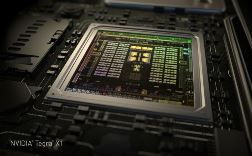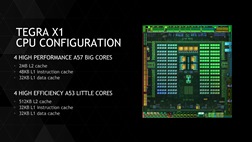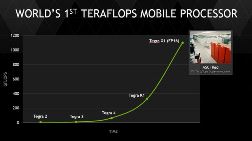
NVIDIA ha annunciato il nuovo SoC per applicazioni mobile denominato Tegra X1, una soluzione che, in accordo ai dati forniti dallo stesso produttore, è in grado di vantare una potenza di elaborazione che supera la soglia di 1 teraflop.
Il maker californiano pone in rilievo che il SoC Tegra X1 include una sezione grafica basata su una GPU realizzata in accordo all'architettura Maxwell, che sappiamo essere stata già impiegata con successo in abbinamento a diversi chip per applicazioni desktop, tra cui l'attuale flag-ship di gamma (GeForce GTX 980).
La GPU del chip Tegra X1 integra 256 core CUDA ed è in grado, secondo NVIDIA, di raddoppiare il livello di performance della soluzione Tegra K1, che appartiene alla generazione precedente e utilizza l'architettura Kepler.
Il SoC Tegra X1 di NVIDIA, che è fabbricato da TSMC con un processo a 20nm, include anche 8 core CPU ARM a 64-bit (più in dettaglio: 4 core ARM Cortex A57 e 4 core ARM Cortex A53), è in grado di effettuare il playback dei video in formato 4K (con codifica H.265, H.264 e VP9) con un frame rate pari a 60fps e supporta le tecnologie grafiche Unreal Engine 4, DirectX 12, OpenGL 4.5, CUDA, OpenGL ES 3.1 e Android Extension Pack (AEP).
Segue il comunicato stampa in lingua inglese e le immagini ufficiali pubblicate da NVIDIA.

[Immagine ad alta risoluzione]

[Immagine ad alta risoluzione]

[Immagine ad alta risoluzione]

NVIDIA today unveiled Tegra X1, its next-generation mobile super chip with over one teraflops of processing power – delivering capabilities that open the door to unprecedented graphics and sophisticated deep learning and computer vision applications.
Tegra X1 is built on the same NVIDIA Maxwell GPU architecture rolled out only months ago for the world's top-performing gaming graphics card, the GeForce GTX 980. The 256-core Tegra X1 provides twice the performance of its predecessor, the Tegra K1, which is based on the previous-generation Kepler architecture and debuted at last year's Consumer Electronics Show.
Tegra processors are built for embedded products, mobile devices, autonomous machines and automotive applications. Tegra X1 will begin appearing in the first half of the year.
It will be featured in the newly announced NVIDIA DRIVE car computers. DRIVE PX is an auto-pilot computing platform that can process video from up to 12 onboard cameras to run capabilities providing Surround-Vision, for a seamless 360-degree view around the car, and Auto-Valet, for true self-parking. DRIVE CX is a complete cockpit platform designed to power the advanced graphics required across the increasing number of screens used for digital clusters, infotainment, head-up displays, virtual mirrors and rear-seat entertainment.
"We see a future of autonomous cars, robots and drones that see and learn, with seeming intelligence that is hard to imagine," said Jen-Hsun Huang, CEO and co-founder, NVIDIA. "They will make possible safer driving, more secure cities and great conveniences for all of us. "To achieve this dream, enormous advances in visual and parallel computing are required. The Tegra X1 mobile super chip, with its one teraflops of processing power, is a giant step into this revolution."
Driven by the exceptional graphics compute horsepower from Maxwell, NVIDIA's 10th-generation GPU architecture, Tegra X1 is the first mobile processor with capabilities that rival supercomputers and game consoles.
Faster Than Previous Top Supercomputer
Indeed, Tegra X1 has more horsepower than the fastest supercomputer of 15 years ago, ASCI Red, which was the world's first teraflops system. Operated for a decade by the U.S. Department of Energy's Sandia National Laboratory, ASCI Red occupied 1,600 square feet and consumed 500,000 watts of power -- with another 500,000 watts needed to cool the room it occupied.
By comparison, Tegra X1 is the size of a thumbnail and draws under 10 watts of power. As serious gamers know from using the NVIDIA GeForce GTX 980 GPU, the Maxwell architecture solves some of the most complex lighting and graphics challenges in visual computing. Its innovations include Voxel Global Illumination, or VXGI, for real-time dynamic global illumination and Multi-Frame Anti-Aliasing, or MFAA, for incredibly lifelike graphics in the most demanding games and apps. "Tegra K1 set a new bar for GPU compute performance, and now just a year later Tegra X1 delivers twice that," said Linley Gwennap, founder and principal analyst of the Linley Group. "This impressive technical achievement benefits both 3D graphics, particularly on devices with high-resolution screens, as well as GPGPU software that is becoming more prevalent, particularly in automotive applications."
Technical Specifications
Tegra X1 supports all major graphics standards, including Unreal Engine 4, DirectX 12, OpenGL 4.5, CUDA, OpenGL ES 3.1 and the Android Extension Pack, making it easier for developers to bring PC games to mobile. Tegra X1's technical specifications include:
- 256-core Maxwell GPU
- 8 CPU cores (4x ARM Cortex A57 + 4x ARM Cortex A53)
- 60 fps 4K video (H.265, H.264, VP9)
- 1.3 gigapixel of camera throughput
- 20nm process
More details are available on the Tegra X1 website.
Source: NVIDIA Press Release
Links



